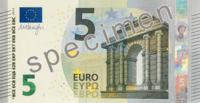
Back ورقة 5 يورو Arabic ৫ ইউরো নোট Bengali/Bangla Bitllet de cinc euros Catalan Χαρτονόμισμα 5 ευρώ Greek Billete de cinco euros Spanish 5-eurone rahatäht Estonian Billet de 5 euros French Billete de 5 euros Galician Uang 5 euro ID Banconota da 5 euro Italian
| (Eurozone (mainly) and other countries) | |
|---|---|
| Value | 5 euro |
| Width | 120 mm |
| Height | 62 mm |
| Security features | First series: hologram stripe with perforations, reflective glossy stripe, EURion constellation, watermarks, raised printing, microprinting, ultraviolet ink, security thread, matted surface, see-through number, barcodes and serial number[1] Europa series: portrait watermark, portrait hologram, emerald number[2] |
| Material used | Cotton fibre[1] |
| Years of printing | 1999–2011 (1st series)[citation needed] Since 2011 (Europa series)[citation needed] |
| Obverse | |
 | |
| Design | Arch in Classical architecture[3] |
| Designer | Robert Kalina (1st series)[4] Reinhold Gerstetter (Europa series)[5] |
| Design date | 3 December 1996 (1st series)[4] 10 January 2013 (Europa series)[6] |
| Reverse | |
 | |
| Design | Bridge in Classical architecture and map of Europe[3] |
| Designer | Robert Kalina (1st series)[4] Reinhold Gerstetter (Europa series)[5] |
| Design date | 3 December 1996 (1st series)[4] 10 January 2013 (Europa series)[6] |
The five-euro note (€5) is the lowest value euro banknote. It has been used since the introduction of the euro (in its cash form) in 2002.[7] The note is used in the 25 countries (and Kosovo) that have it as their sole currency (with 24 legally adopting it), which countries have a total population of about 350 million currently.[8] In July 2024, there were approximately 2,211,000,000 five-euro banknotes in circulation around the eurozone. It is the fifth-most widely circulated denomination, accounting for 7.2% of the total banknotes.[9] Estimates suggest that the average life of a five-euro banknote is less than a year before it is replaced due to wear.[10]
Measuring 120 x 62 mm, it is the smallest of the euro notes, and has a grey colour scheme.[3] The five-euro banknotes depict bridges and arches/doorways in Classical architecture (8th century BC–4th century AD). The five-euro note contains several complex security features such as watermarks, invisible ink, holograms and microprinting that document its authenticity.
On 8 November 2012, the European Central Bank announced the first series of notes will be replaced by the Europa series, starting with the five-euro note.[11] The design of the Europa series 5 euro banknote was revealed on 10 January 2013 and launched on 2 May 2013.[12]
- ^ a b "ECB: Security Features". European Central Bank. ecb.int. 2002. Archived from the original on 2012-08-30. Retrieved 22 October 2011.
- ^ "ECB: Security features". European Central Bank. ecb.int. Retrieved 9 July 2015.
- ^ a b c "ECB: Banknotes". European Central Bank. 2002. Retrieved 1 January 2013.
- ^ a b c d "Banknotes design". ECB.int. European Central Bank. February 1996. Archived from the original on 10 May 2013. Retrieved 13 October 2011.
- ^ a b "Europa series design - ECB - Our Money". www.new-euro-banknotes.eu. 2013. Retrieved 6 August 2013.
- ^ a b "ECB: Europa series". ECB. 2013. Retrieved 24 June 2013.
- ^ "Witnessing a milestone in European history". The Herald. Back Issue. 1 January 2002. Archived from the original on 8 November 2012. Retrieved 23 October 2011.
- ^ * "ECB: Map of euro area". ECB. ecb.int. 1 January 2023. Retrieved 25 November 2024.
- "By monetary agreement between France (acting for the EC) and Monaco". 31 May 2002. Retrieved 30 May 2010.
- "By monetary agreement between Italy (acting for the EC) and San Marino". 27 July 2001. Retrieved 30 May 2010.
- "By monetary agreement between Italy (acting for the EC) and Vatican City". 25 October 2001. Retrieved 30 May 2010.
- "By monetary agreement between European Union and the Principality of Andorra". 17 December 2011. Retrieved 25 November 2024.
- ^ "ECB Statistical Data Warehouse,Reports>ECB/Eurosystem policy>Banknotes and coins statistics>1.Euro banknotes>1.1 Quantities". ECB. European Central Bank.
- ^ "Eurozone's new 5-euro note: Coming to a wallet near you". Deutsche Welle.
- ^ Eurosystem to introduce second series of euro banknotes – the “Europa” series
- ^ Eurosystem unveils the Europa series €5 banknote